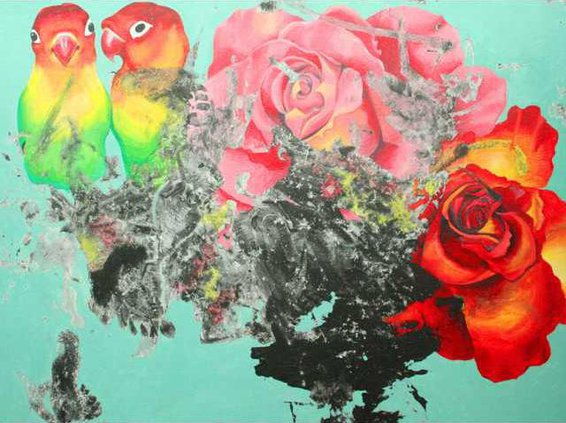This month’s exhibition at the Hinesville Area Arts Council gallery will present social commentary through a variety of media.
“It’s a collection of more symbolic and meaningful work than my last show. My last show was mostly landscapes from central New York, and this show is a lot of surreal, and a little more poignant,” exhibitor Ashley Kukula Cuevas said. “And bigger.”
Cuevas christened the gallery as its first official exhibitor when the 102 Commerce St. gallery opened. Then, she was a military spouse who had just moved to the community. Now, the New Yorker with a Master’s of Education in curriculum and art instruction has a base of friends established and teaches more than five monthly arts council classes.
Having those ties to the community allows Cuevas to push the boundaries a bit more — she now teaches three children’s classes and two adult classes every month in addition to bi-monthly adult painting parties.
“If people come, they’re going to be surprised, because this is unlike the other shows that have been in the gallery,” Cuevas said. “I know we do a lot of local photography and coastal scenes and some groups do shows, but I haven’t seen a lot of social commentary and surrealism in it and such a wide variety of media.”
The show has been open since April 1, but a 5:30-7 p.m. reception Thursday will allow visitors to mingle with the artist as they take in her 32 pieces. And there are multiple pieces each of metal and ceramic sculpture, printmaking, drawing, painting and collage.
“The title of the show is ‘A Distance Test,’ and the term is something that I use when I teach,” she said. “It’s when you take an artwork that you’re working on and you set it far away from you, and you kind of step back to look at it. The point of that exercise is to get a feel of the whole of the piece, to stop getting bogged down in the parts and judge the whole.”
The artist said the exercise also applies also to motherhood, marriage, body image and life in general — themes the exhibition explores.
Each piece will have an artist reflection next to it so people can understand the intended message of the piece.
“I have very specific messages behind these pieces, so I thought it would be preferable to have my perspective next to each one of them,” she added.
“You kind of are looking at things as a whole and evaluating them, so it’s a little bit about evaluating and reacting to the world around me,” she said.
While there are works created as far back as 2004, Cuevas said she began creating pieces for the show in September. She completed the collection only days before the show opened. The focal point of the show took her 73 hours to paint.
“Ever since I was a teenager I started to ask myself why the women around me always pointed out things that they didn’t like about themselves. I became very interested in why women are so hard on themselves,” she said. “I’m trying to point out how impractical and unhealthy these ideal features are … and for us to always feel like we should be better than we are naturally, so that’s kind of what I talk about with the body image.”
With marriage, she reflects on the commitment and how it is affected by a child.
When it comes to motherhood, her art reflects on the responsibilities and controversies that come with rearing children.
With each theme, Cuevas wants her viewers to ask why society operates the way it does.
“I think a lot of people should be critical of what is the social norm,” she added.
“I’m hoping that people will look at some of the things I’m showing a little more critically. I want them to ask critical questions about body image and why there’s such a skewed view of that. I want people to ask questions about post-partum issues. And I want people to ask questions about whether or not they agree with me, and why. Not just ‘This is what I think,’ but ‘Why do you think that way?’”
Exhibit offers social commentary


Sign up for our e-newsletters